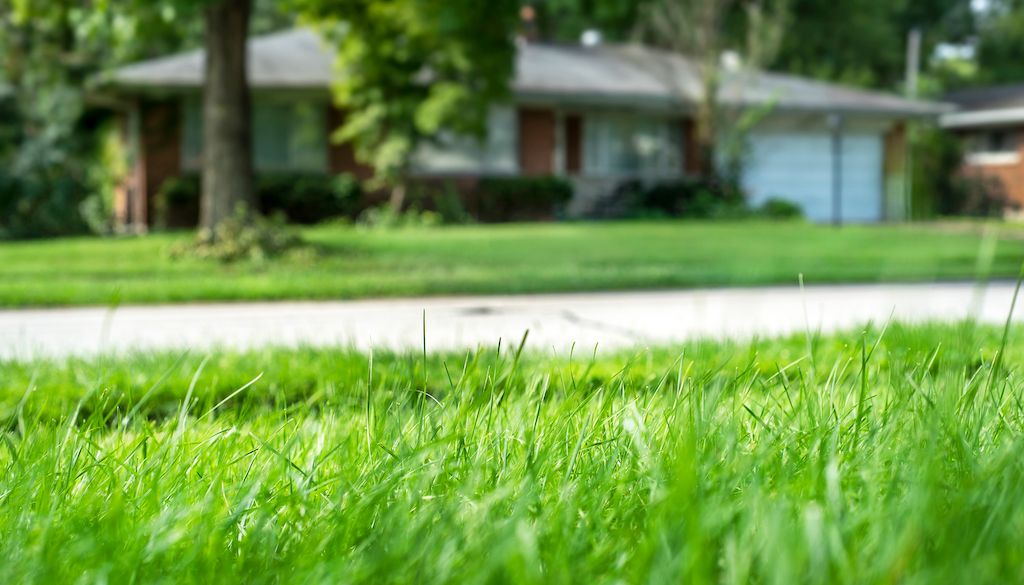Here's how often you should cut your grass.
According to the National Association of Landscape Professionals, the ideal mowing height for cool-season grasses falls between 2-3.5 inches. For warm-season grasses, it's 1-3 inches tall.
Here's a quick chart to help you recognize when it's time to mow your grass depending on the type and grass height:
Grass type | Grass species | Mow when the grass reaches… | Set your mower to… |
Cool season | Annual ryegrass | 2.25-3 inches | 1.5-2 inches |
Warm season | Bermuda | 1.5-2.25 inches (for seeded bermudagrass) .75-1.5 inches (for hybrids) | 1-1.5 inches (for seeded bermudagrass) .5-1 inch (for hybrids) |
Warm season | Buffalograss | 1.5-3 inches | 1-2 inches |
Cool season | Colonial bentgrass | .75-1.5 inches | 0.5-1 inch |
Cool season | Creeping bentgrass | .75 inch or less | 0.5 inch or less |
Warm season | Dichondra | .75-1.125 inches | 0.5-.75 inch (can remain unmowed) |
Cool season | Hard fescue | 3.75 inches | 2.5 inches |
Cool season | Kentucky bluegrass | 2.25-3.75 inches | 1.5-2.5 inches |
Warm season | Kikuyugrass | 1.5-2.25 inches | 1-1.5 inches |
Cool season | Perennial ryegrass | 2.25-3.75 inches | 1.5-2.5 inches |
Cool season | Red fescue | 2.25-3.75 inches | 1.5-2.5 inches |
Cool season | Rough bluegrass | 1.5-3.75 inches | 1-2.5 inches |
Warm season | Seashore paspalum | 1.125-2.25 inches | .75-1.5 inches |
Warm season | St. Augustine | 1.5-3 inches | 1-2 inches |
Cool season | Tall fescue | 2.25-4.5 inches | 1.5-3 inches |
Warm season | Zoysia | 0.75-1.5 inches | 0.5-1 inch |
Source: Agriculture and Natural Resources, University of California
Signs it’s time to mow your lawn.
 Generally, there are a few signs it’s a good idea to sharpen dull mower blades and prepare them for mowing:
Generally, there are a few signs it’s a good idea to sharpen dull mower blades and prepare them for mowing:
- The grass blades have exceeded one-third of their optimal height. Once the grass has grown one-third above its optimal height, you can mow one-third of the leaf blade.
- You’ve entered peak growing season. Once you’ve reached peak growing season, the grass will typically start to flourish and will need more frequent lawn care.
- Soil temperatures have reached 50°F. When soil temperatures reach 50°F, the grass root systems will likely start initiating signs of growth. That indicates you can start moving into a spring lawn care and mowing schedule.
How often to cut your grass in the spring, summer, fall and winter.
Optimal seasonal mowing frequency depends on your lawn type. You can eyeball its growth to see when it reaches more than one-third of its optimal height in the winter, summer, spring and fall.
Generally, cool-season grasses will grow more vigorously during spring and fall seasons, so those are the times you’ll be mowing more frequently, depending on grass height. During the hot months of summer and cold months of winter, growth will continue but at a slower pace.
Warm-season grasses will grow most vigorously during warm and hot summer months, so you’ll want to create a summer lawn care strategy to optimize growth. These grasses will also thrive when rainfall is more frequent.
Whatever type of grass you have, use the blade height as a guide for how often to mow the lawn. You’ll likely need to mow more frequently during the growing season and less frequently the rest of the time.
Related: What temperature is too hot to water grass?
Hire a lawn mowing service on Thumbtack.
Improper mowing can stress out grass and damage its growth potential. If you want a green and healthy-looking lawn, it’s important to understand its growth patterns and mow at the right times.
A lawn care expert can help you determine a good mowing schedule and ensure proper mowing techniques help the grass grow at optimal levels. If you’re new to mowing lawns or want to work with a pro to keep your grass looking great, download the Thumbtack app and hire a professional.
Related: How much do lawn services cost?
FAQs
Does frequent mowing thicken grass?
It depends. As long as you’re not cutting grass too short, frequent mowing can thicken grass. That’s because when blades are cut into grass clippings, the grass produces more growth to improve photosynthesis. That can result in a thicker lawn.
Is it better to leave our lawn long or short for winter?
As detailed in our fall lawn care guide, the last mow of the fall should be on the shorter side. This helps prevent pests and mold from damaging your lawn.
A note about project costs included or linked in this article: Figures represent national average cost estimates using data provided by Thumbtack pros and additional research. These figures are provided for educational purposes only and are subject to change at any time due to various factors. Details about your specific project and local rates can impact costs.